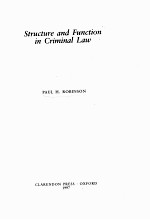图书介绍
STRUCTURE AND FUNCTION IN CRIMINAL LAWPDF|Epub|txt|kindle电子书版本网盘下载

- PAUL H.ROBINSON 著
- 出版社: CLARENDON PRESS·OXFORD
- ISBN:0198258860
- 出版时间:1997
- 标注页数:251页
- 文件大小:12MB
- 文件页数:280页
- 主题词:
PDF下载
下载说明
STRUCTURE AND FUNCTION IN CRIMINAL LAWPDF格式电子书版下载
下载的文件为RAR压缩包。需要使用解压软件进行解压得到PDF格式图书。建议使用BT下载工具Free Download Manager进行下载,简称FDM(免费,没有广告,支持多平台)。本站资源全部打包为BT种子。所以需要使用专业的BT下载软件进行下载。如BitComet qBittorrent uTorrent等BT下载工具。迅雷目前由于本站不是热门资源。不推荐使用!后期资源热门了。安装了迅雷也可以迅雷进行下载!
(文件页数 要大于 标注页数,上中下等多册电子书除外)
注意:本站所有压缩包均有解压码: 点击下载压缩包解压工具
图书目录
PART Ⅰ.INTRODUCTION1
Chapter 1.Structure and Function in Criminal Law3
A.The Formal Structure of Current Criminal Law4
B.The Operational Structure of Current Criminal Law6
C.A Functional Structure of Criminal Law8
PART Ⅱ.THE CURRENT OPERATIONAL STRUCTURE9
Chapter 2.The Basic Organizing Distinctions of Current Law11
A.The Offence-Defence Distinction11
B.The Current Operational Structure: Offence Definitions,Doctrines of Imputation, and General Defences12
Chapter 3.Offence Requirements16
A.The Conceptual Difficulties of the Actus Reus-Mens Rea Distinction16
1.Conceptual Diversity Within Actus Reus and Within Mens Rea17
2.Terminological Confusion Among the Doctrines of ‘Actus Reus’19
3.Conclusion and Proposal: Objective, Culpability, and Act-Omission Requirements22
B.Objective Elements of Offence Definitions23
1.Weaknesses in the Objective Element Categorization Scheme of Conduct, Circumstance, and Result Elements25
2.Confusion in the Modern Code Conceptualization of Causation Requirements27
C.The Act-Omission Requirements and the Involuntariness Defence31
1.The Role of the Statutory Act Requirement31
2.The Voluntariness Requirement as an Excuse35
D.Culpability Elements of Offence Definitions39
1.The Evolution to Element Analysis39
2.The Culpability Distinctions42
3.Asymmetry in the Definition of Culpability Requirements44
4.Difficulties With Modern American Culpability Schemes49
Chapter 4.Principles of Imputation57
A.The Process of Imputation57
B.The Doctrines of Imputation59
C.The Theories of Imputation64
Chapter 5.General Defences68
A.Non-exculpatory Defences71
1.Minimizing the Societal Costs of Non-exculpatory Defences72
2.The Nature of the Entrapment Defence78
B.Excuses81
1.The Internal Structure of Excuse Defences83
1.1 The Disability Requirement84
1.2 Four Kinds of Excusing Conditions and Their Implications85
1.3 Objective Limitations on Excusing Conditions88
2.A Disability-organized System of Excuses and the Problem of Multiple Excuses92
C.Justifications95
1.Three Kinds of Justification Defences96
2.The Internal Structure of Justification Defences98
3.Competing Theories of Justification:Deeds v.Reasons100
4.Incompatibility Between ‘Reasons’ Rationale and Current Law’s ‘Believes’ Formulations104
5.‘Deeds’ v.‘Reasons’: Liability Results105
5.1 Mistake as to a Justification105
5.1(1) Liability for Resisting a Mistaken Justification105
5.1(2) Privileged v.Unprivileged Force106
5.2 Unknowingly Justified Actor108
5.2(1) Disagreement over the Significance of Resulting Harm109
5.2(2) Unknowing Justification as a Legally Impossible Attempt111
5.2(3) Liability for Resisting an Unknowingly Justified Actor113
5.3 Summary of Liability Results114
6.‘Deeds’ v.‘Reasons’: Terminology and Conceptualization115
6.1 Clarity of Conceptualization: ‘Justification and Excuse’ v.‘Privileged Justification,Unprivileged Justification, and Excuse’115
6.2 Articulating the Criminal Law’s Commands to Those Bound by Them118
7.The Deeds-Reasons Dual Requirement Proposal121
8.Deeds v.Reasons: Summary and Conclusion123
PART Ⅲ.FUNCTIONAL STRUCTURE125
Chapter 6.A Functional Analysis of Criminal Law127
A.The Standard Conceptualization128
1.‘Actus Reus’ Requirements128
2.‘Mens Rea’ Requirements129
3.Defences137
B.Rule Articulation, Liability Assignment, and Grading138
Chapter 7.The Rules of Conduct143
A.Obscuring Rules of Conduct with an Overlay of Liability and Grading Rules143
B.Confusing Conduct Rules and Liability Judgements:Ambiguous Acquittals145
C.Mixing Rule Articulation and Liability Functions by Defining ‘Justified’ Conduct Subjectively: The Failure to Define the Justified Conduct Rules146
D.Mixing Conduct Rules of Risk-Creation with Liability Judgements of Risk-taking: The Failure to Define Criminal Risks148
E.Conclusion155
Chapter 8.The Doctrines of Liability157
A.Elevating Base and Aggravation Culpability Requirements to the Status of Criminalization Mental States:Improperly Limiting Attempt Liability157
B.Obscuring the Voluntariness Requirement’s Shared Liability Function with Excuses: Distorting the Involuntary Act Defence164
C.Conclusion169
Chapter 9.The Doctrines of Grading171
A.Mixing Liability and Grading by Using Culpability Terms to Define Prohibited Risks: Aggravation of Grade for Risk-Creation in the Absence of a Criminal Risk172
B.Incomplete and Unsystematic Use of Central Grading Factors174
C.Dichotomous v.Continuous Judgements: Using Rule-articulation and Liability-assignment Forms in Grading176
D.Grading v.Sentencing: The Arguments Against Judicial Sentencing as a Substitute for Grading178
E.Conclusion181
PART Ⅳ.USING STRUCTURE TO ADVANCEFUNCTION183
Chapter 10.Drafting a Code of Conduct185
A.Eliminate Liability and Grading Language185
B.Consolidate Overlapping Offences187
C.Simplify Justification Defences188
D.Use Simple, Accessible Language190
E.Track Community Views Where Possible194
Chapter 11.Drafting a Code of Adjudication196
A.Adopt a Code Structure that Matches the Analytical Process196
B.Include All Articulable Rules Relevant to Adjudication198
C.Use General Principles Whenever Possible199
D.Use Parallel Language in Conceptually Analogous Provisions201
E.Provide Jury Verdicts that Make Clear Their Meaning204
F.The Case Against ‘Acoustic Separation’207
Appendix A: A Code of Criminal Conduct211
Appendix B: A Code of Criminal Adjudication221
Index241